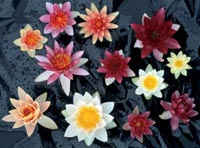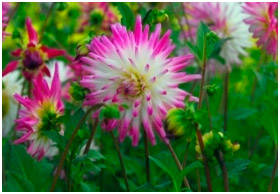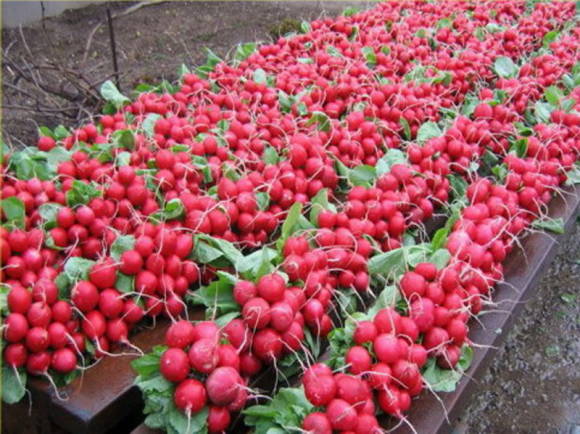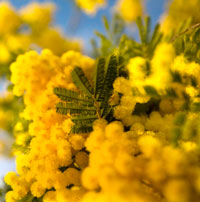The fourth hunt - the hunt for rare plants
The first hunt is just a hunt. The second hunt is fishing. "The Third Hunt" (my fellow countryman, Vladimir Soloukhin, a writer from Vladimir, has such a story) is a mushroom picking. As for the fourth hunt, there are no judgments yet, except for the fabrications of your humble servant. The very ones in which I am immersing you now.
So, bull by the horns! I propose to call the search and purchase of garden plants the fourth hunt. And the extreme manifestation of this hobby will be considered "crazy about plants." This is when the acquisition of new plants takes on the character of passion, a kind of mental disorder. And this disease is called collecting.
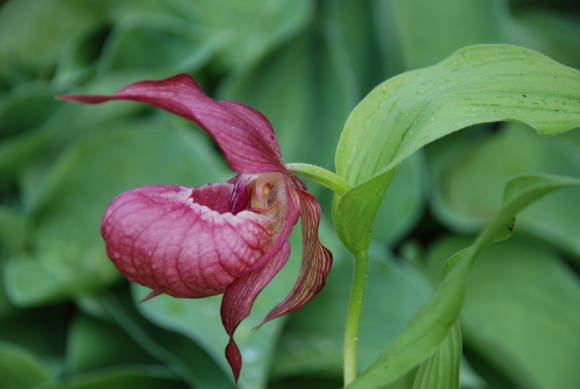 |
Collecting plants is a separate topic. Let's leave it aside and go back a little. In fact, the Russian word "hunting" in its original meaning meant a strong desire (desire, hunting), love, passion for something. The hunter is already something extraordinary. There are never too many real hunters, in any area. For example, almost everyone goes for mushrooms from time to time, but there are only a few “mushroom hunters” - true experts and amateurs of this business.
As for the hunt for plants, this is absolutely not for everyone. There are far fewer plant hunters than mushroom pickers, fishermen and people with guns. Since I myself have tried all four hunts (I hunted animals, I caught fish, and I collected mushrooms, but now I have reached grasses and bushes), I have the right to compare them with each other.
What is the specificity of hunting for plants? This occupation of all the hunts is the smartest, the most science-intensive. Firstly, there are much more plants than fish, objects of gun hunting, and mushrooms. Plants, in comparison with all this, are simply dark darkness. And besides, it is not enough to get a plant, it must be kept alive and healthy. And this requires not only a comprehensive understanding of its biology. This is theory. But also to do a chain of actions. This is practice.
That is why the hunt for plants attracts the most intellectual part of the "hunters". And mind, I note, is not such a trifling characteristic for a "reasonable man." In general, plant hunters (and even more so, collectors) are a very special caste. These are people with a fine mental organization, they are the elite of the horticultural community. These are the knights of the round table, who have chosen as their paths the service of plant beauty and harmony.
Plant hunting is a real gentleman's business
 |
I repent, I repent! I myself had a hand in all the listed hunts. There was even a period when I had enough for three at a time. And although the fascination with plants came last, it turned out to be so contagious that hunting and fishing were completely abandoned.
And that's what I think - all hunts have one thing in common - they give rise to the excitement of searching, tracking. And all, whatever one may say, requires patience, experience and knowledge. And plant hunting is the greatest. And if other boobies see a botanist as a kind of eccentric not of this world, then because of their lack of that very gray matter, thanks to which man (Homo) was awarded the species-wise epithet (sapiens).
The very concept of "plant hunter" was born in the era of great geographical discoveries, when researchers rushed to unknown lands: geographers, cartographers, biologists ... This work was associated with many dangers and great hardships. After all, most often it was necessary to move on foot in wild, undeveloped lands, and spend the night in the open air. For example, the famous Russian discoverer Karl Maksimovich for seven whole years - where on horse, where on boat, and mostly on foot, "wandered" in Eastern Siberia and the Far East. Over the years of travel, he discovered and described 120 previously unknown plants ... and killed two dozen bears.In general, the first plant hunters were most consistent with the current concept of the "gentleman of fortune". Think of the cinematic Indiana Jones. This is how they were, if we subtract the “amorous-romantic” component of his image.
Or the famous David Douglas (aka Douglas), a reckless pioneer traveler and plant hunter. Scottish by birth, David Douglas was a tireless seeker of new plants, a gentleman of fortune and a fair amount of adventurer, in the best sense of the word. He devoted more than ten years of his life to hunting plants. Over the years of his wanderings, the brave discoverer transported 240 species of new plants from the New World to England. During his travels, he repeatedly fell into dangerous alterations and, in the end, died tragically, accidentally falling into a hunting trap in Hawaii. And he was then only 35 years old.
By the way, in those days, hunting for plants could be a very profitable business. As they used to say, it was possible to make a fortune on this. Take, for example, the orchid fishery in Borneo, which peaked in the first half of the 19th century, when the orchid boom hit Europe. A whole army of botanists-adventurers (Dutch, Belgians, Germans) then rushed to Southeast Asia for the most beautiful tropical flowers. Of course, success in this matter was determined not only and not so much by courage. Extraordinary knowledge and experience were needed to deliver exotic flowers intact to the “end consumer”.
Among those with whom I have to deal with "by the nature of the service", no, no, yes, and there will be a modern hunter (or hunter) for plants. Today's plant hunters hardly risk their lives. The typical plant hunter is now more a woman than a man. Someone goes to the Czech Republic for exotic novelties, someone to Germany. And someone is smuggling plants from Poland.
Rare guests
There are several reasons that make us choose certain plants for the garden. The main three are reflected in their very division into food, medicinal and decorative. Rare plants are a separate topic. The possession of a rarity is attractive in itself. But in any case, rarity is not an end in itself, we still choose plants for their useful qualities, which include beauty.
To begin with, the rarity of the rarity is different. For example, such medicinal plants as calamus, marshmallow, valerian, elecampane, burnet, agaric. You rarely see them in the garden, although it is not difficult to grow them - there would only be a desire. Even if you forget about them, they will survive.
A completely different matter is such plants as slipper, sleep-grass, adonis, lavender, belamkanda. These are already quite difficult species in agricultural technology. Only enthusiastic gardeners can grow such plants - persistent and hardworking.
 |
Spring adonis, Adonis (Adonisvernalis)... It's just amazing why Adonis is still a rare guest in Russian front gardens, especially since he is Russian by origin. This flower from the buttercup family grows wildly in the forest-steppe and steppe zones of the European part of Russia. The unusually bright and large flowers of adonis will not leave anyone indifferent. They alone are a reason to invite this herbaceous perennial to the front garden. But besides this, adonis is a valuable medicinal plant, for which it has already paid a lot with its numbers in nature.
Oddly enough, adonis is not a difficult plant in agricultural technology, although its culture has its own characteristics. It is undemanding to soil fertility, but prefers light and well-drained soils. However, ideally, plenty of sun and humus will only benefit Adonis. But if the plant gets everything it needs, it grows steadily and for a very long time, to the delight of the owner, and practically without causing any trouble.
The main reason for the low prevalence of adonis is the difficulty of its reproduction. He does not tolerate division and transplantation as an adult. The main way of its reproduction is seed. But he also has little success. Only freshly harvested seeds germinate, and the seedlings, until they get stronger, are extremely tender. In addition, in the Non-Black Earth Region, the seeds of adonis most often do not ripen. In order for the seeds to set and ripen, the plant must be as pleasing as possible. The location is chosen more or less elevated, completely open. Waterlogging is unacceptable! The soil is permeable to adonis; dry rather than wet; and non-acidic - optimal pH 7.0-7.5.
As for division, it is still possible. Divide is shown for adults, but not too old bushes at the age of 7-10 years. The most favorable time is mid-August, and the number of divisions is no more than 3-4.
Arisema Amur (Arisaemaamurensis). Arisema is a relative of calamus and calla lilies. In the aroid family, to which these plants belong, arizema is one of the largest genera: there are about 100 species of aryzem on Earth. The flower (more correctly - the inflorescence) of arizem is interesting for its unusual shape. This is a typical aroid ear, covered with an elaborate veil, similar to the headdress of the Capuchin monks. Arizemas are one of the most attractive and most interesting, from the point of view of outdoor gardening, aroids. But mostly they are subtropical and tropical inhabitants, and the prospect of acquaintance with the Russian winter does not bode well for them.
 |  |
It should be mentioned that Russia is home to three types of arizema. Amur Arisema - although not the brightest, but the northernmost and most frost-resistant of all Aryzem. In central Russia, she hibernates without problems. Its corms hibernate without any consequences even in container pots left standing on the ground - not covered with anything, which means they freeze through.
Arizema Amur is quite unpretentious, but grows better on constantly moist, humus-rich, loose soils. Shade tolerant, but prefers an open location. An exotic appearance suggests the use of arizem in compositions dedicated to it: mini gardens, scenes with stones, etc.
Read more in the article Arisema changes gender.
 |
Mountain arnica (Arnicamontana).Arnica is one of the most popular medicinal plants in European medicine, recognized by the pharmacopoeias of all countries where this plant occurs in nature. And, as a result, this once common herb was included in the Red Book. They tried to introduce it into the culture many times, but to no avail. Growing arnica in the fields by machine is really difficult. After all, arnica is a perennial herb, and its rhizome is relatively shallow, horizontal. In addition, arnica's medicinal raw materials are flower baskets. It is also difficult to mechanize their collection.
Meanwhile, this plant is quite unpretentious, albeit with some peculiarities in agricultural technology. Take reproduction, for example. Propagating arnica by division is unproductive. The best way is seed. But the seeds must be sown on time and correctly. They are harvested at the beginning of the browning of the baskets, and immediately sown. Seeds should not be buried as they may not sprout. They sow superficially, and so that the light fluffs of seeds are not blown away by the wind, they are slightly sprinkled with peat dust or other friable organic matter. If the weather is warm and humid, then shoots appear in 1.5-2 weeks. Next spring, the "seedlings" can already be transferred to a permanent place. It is advisable to grow arnica in a separate bed. The garden bed is organized in a relatively dry, sunny place. Already in the third year, the arnica seedlings begin to bloom. The "bed" reaches its highest productivity at the age of 5-6 years. Plants can be grown in one place for a long time. Periwinkle large (Vincamajor). This type of periwinkle is found in the gardens of Russians much less often than its smaller brother, the small periwinkle(Vincaminor). Meanwhile, it is no less valuable for the garden. The flowers of the large periwinkle are of the same sky-blue color, but slightly larger. The leaves are heart-shaped and have a pleasant dark green dullness. In terms of winter hardiness, a large one is inferior to a small one, but, as a rule, it winters steadily. If it freezes, then no more than once every three years, and quickly recovers. The plant grows well in cultivated, loose garden soils. Prefers light partial shade. It spreads less actively than the lesser periwinkle. Real slipper (Cypripediumcalceolus). The orchid family, according to our human concepts, is one of the most "beautiful" and brightest in the plant kingdom. By the way, and it is not small in number - botanists estimate its number at about 20-25 thousand species (sometimes they even call the figure 35 thousand). This means that the species diversity of orchids is the largest among modern flowering plants. The fact that orchids are more or less evenly distributed over the earth's surface suggests their ancient origin. Scientists explain the variety and color of their flower corollas by the fact that orchids are mainly pollinated by insects. And in order to please a butterfly, a fly, a dragonfly ... or even a small hummingbird, the flower should look like them. Indeed, orchid flowers are simply stunning with the pretentiousness of their forms and the luxury of colors. And, oddly enough, orchids grow not only in the tropics. In the Russian territory, for example, at least 300 species of orchids have been recorded. True, many of them (about 70 species) are so rare that they are included in the Red Book. The orchids of the north are as beautiful as their tropical sisters, but are overwhelmingly too small to be as delightful as the large and flowery Tropicans. The most beautiful of the temperate climate orchids are undoubtedly the slippers. This genus has about 36 species, of which 4 species live on Russian territory, and all of them are in the Red Book. The common slipper is the most common of our slippers, but it is also endangered. The flower of the shoe surprisingly resembles a miniature shoe. It even has a decorative bow. Of course, nature created such a structure not at all for the delight of human eyes. It has been established that the pollinators of this flower are mainly dipterans (flies, etc.), attracted by the odor (pheromone) emitted by the flower. The insect gets inside the "shoe" and crawls through it, and on the way, unknowingly, pollinates it. The vulnerability of northern orchids is related to two main factors. First, orchids are already initially vulnerable due to their narrowly specific environmental requirements. In essence, our orchids are indicators of nature's health. Orchids are among the first to react to environmental pollution. For well-being, orchids need not only a certain illumination, but also a healthy soil of a strictly defined composition, moisture, acidity. But that's not all. They need "pleasant" neighbors: plant and mushroom (mycorrhiza). But the main offenders of orchids are people. Due to the disruption of natural communities and the collection of flowers, northern orchids are under strong anthropogenic pressure. Therefore, do not dig orchids in the forest, and do not transfer them to your gardens! In the vast majority of cases, you will fail. Chinese Belamkanda (Belamcandachinensis)... A plant connoisseur can easily guess the relative of the iris in Belamkand. Until recently, this graceful flower stood out as a separate monotypic genus, but after molecular studies, in 2005, the plant was included in the iris genus. (Iris), and its current scientific name is homemade iris (Iris domestica). Against the background of fanciful bearded irises, the belamcanda flower may seem ingenuous, and even rustic.An asymmetrical corolla of six different-sized, almost monochromatic red petals, only slightly tinted with brownish spots, and xiphoid leaves, unfolded in a flat fan. But it’s hard not to agree that, for all its simplicity, Belamkanda is very pretty. The plant has a height of 50-70 cm, begins to bloom at the end of June and blooms for at least 1.5 months. Fruits, shiny black balls, fully ripen only in the most favorable seasons. Belamkanda has a fairly extensive area. Arched along the shores of Asia, the area of its distribution extends from the eastern states of India, through Southeast Asia, China and Korea to the south of the Russian Primorye. Thus, in our country it is located at the extreme northern point of its range and because of this it is rare and included in the Red Book of Russia as an endangered species. Belamkanda is more thermophilic than most iris varieties. In years when severe frosts come before snow falls, the plant may freeze out. But in favorable places, as experience shows, a plant can not only grow for years, but also generate viable seeds. For successful cultivation, the plant should choose a slightly elevated, sunny location with light, but sufficiently fertile soil. Belamkanda is organic surrounded by boulder stones. Small dense groups of 3-7 plants look interesting. Butterbur wide (Petasitesamplus) is one of the most powerful herbs that can grow in our gardens. Even in central Russia, a butterbur leaf can reach 70 cm in diameter, and its petiole is a meter long (height). At home (Sakhalin, Primorye, Kuril Islands), the plant is even larger. Butterbur is a stemless plant, its leaves grow directly from the powerful surface rhizome. On light, moist and sufficiently fertile soils, the plant displaces other vegetation and forms dense uniform thickets. Butterbur blooms in early spring, immediately after the snow melts, the flowers are yellow baskets typical of Compositae, collected in dense umbellate brushes. Butterbur is a large plant, rather a landscape plant than a six-acre plant. Its main purpose is to decorate the shores of reservoirs; the creation of various sizes of dense thickets in places where its spread does not pose a threat, or where there are natural barriers to the spread of plants: ditches filled with water, paths, buildings, dense trees or shrubs, etc. Butterbur agrotechnics is extremely simple. The plant is undemanding to soil fertility, drought-resistant, tolerates a slight shade. But it grows best in the open sun, on fairly fertile, moderately moist sandy loam soils. Syrian cotton wool (Asclepiassyriaca) - a large perennial herb of the Grimaceae family. Vatochnik is interesting for gardeners as an ornamental, aromatic and melliferous plant. It is curious that the specific epithet was given to vatochnik by mistake, in fact, his homeland is North America. This plant attracts attention for a variety of reasons. Firstly, this is a prominent, tall (100-180 cm tall) plant with beautiful ornamental leaves and creamy pink bell-shaped flowers, collected in original multi-flowered (up to 100 pcs.) Hanging racemose umbrellas arranged in several tiers. Secondly, the flowers of the fleece have a strong "perfume" aroma: in the midst of flowering, the smell of the flowers of the fleece can be felt from a dozen meters away. And if thickets of cotton wool occupy a more or less vast territory, then even a good hundred meters away - is there still such a grass ?! By the way, in Europe, cotton wool is often cultivated for its fragrant essential oils - raw materials for the aromatization of toilet soap and even for perfumes. And, thirdly, cotton wool is an excellent melliferous plant, valuable for late and long flowering.In central Russia, the fleece blooms in early July and blooms for more than a month. According to the reference data, the honey productivity of the willow herb, depending on the growing conditions, is 45-150 kg / ha. The roots of the fleece are rather thick, cord-like, spread mainly in the surface layer of the soil. Vatochnik drought-resistant, unpretentious. Under favorable conditions - on fertile light soils and in full light - the willow grows widely, forming more or less dense thickets. The disadvantage of the plant is some of its aggressiveness. Therefore, in the front garden, cotton wool should be grown with an underground restriction, for example, in an old tank without a bottom. The container must be deep enough, at least 35 cm, otherwise the fleece cannot be held. By the way, the “restriction of freedom” is only beneficial to the vatnik - not being able to spread in breadth, it grows in a dense, highly decorative sheaf. It looks very impressive. Jeffersonia dubious (Jeffersoniadubia) - this perennial plant is interesting for its antiquity. Jeffersonia is a relic of the Tertiary period. Once this plant was distributed throughout the Russian Far East. Glaciation drove Jeffersonia from its former habitats to the south, and now it is found only where the glacier did not reach - in the Primorsky and Khabarovsk territories and to the south - in Korea and northeastern China. Jeffersonia is a distant relative of the barberry, although outwardly it does not look like him in any way. From the point of view of the gardener, the most attractive thing about Jefferson is its decorative effect. We can say that this plant has no flaws: Jeffersonia has good flowers, leaves, and the general warehouse of the bush. Pleasant appearance has already reverberated on Jefferson by thinning out its natural reserves near cities. Fortunately, its habitats are sparsely populated, otherwise the beauty of the Red Book would not escape. Jeffersonia blooms in early spring - usually in early May. The flowers have wide-open, upward-facing corollas of 5-6 petals of bluish or lilac shades. They begin to bloom before the leaves. Flowering lasts up to three weeks and ends already with completely leafy bushes. Jeffersonia leaves grow directly from the rhizome on long and thin petioles, forming pretty compact bushes. They have a rounded shape with a characteristic notch at the apex. As they grow, Jeffersonia's leaf blades undergo color metamorphosis. At first they are reddish purple; then turn green, retaining a reddish border, and finally become completely green by mid-summer. Attractively, Jeffersonia leaf blades do not lose their freshness from the moment of deployment until the end of summer. Growing Jeffersonia is not a big deal, but there are a few things you need to know. Jeffersonia should not be planted in the sun, she loves mesh penumbra. The soil should be moist and fertile, and in terms of texture it should be light or medium loamy. In favorable conditions, Jeffersonia is capable of self-seeding, but in practice, the main method of its reproduction is still division. Dioscorea of Nippon (Dioscoreanipponica)... This climbing perennial herbaceous vine appeared in our garden in 1989. The plant attracts with many qualities. In the first place, perhaps, is its original appearance. Dioscorea leaves have finger venation, unusual for our plants. They have sharply drawn tops and are located on the liana with droppers down. Tiled overlapping on each other, they form a dense and highly decorative leaf mosaic. In this case, the leaf blades direct rainfall to the area of occurrence of a short tuberous rhizome. Dioscorea's flowers are very small, nondescript greenish-yellow in color. Fruits are three-celled capsules about 15 mm long. Shoots are thin, slightly branched, up to 2.5 m long. There are more than 600 types of dioscoreas in the world.Almost all of them are herbaceous vines with thick tuberous rhizomes. Dioscoreas are mainly tropical plants. Dioscorea Nippon is the most northern and winter-hardy of all. In Russia, it grows in Primorye and in the south of the Khabarovsk Territory. Dioscorea is a valuable medicinal plant. Its rhizomes are used to produce steroid hormones. It also has an anti-sclerotic effect. Oddly enough, breeding Dioscorea is not difficult. The main thing is to choose the right place of growth. It should be sunny. For normal development, the plant needs support; it is better to make it metal. The soil should be light, fertile, moderately moist. Subject to these conditions, the vine does not cause any trouble, it grows steadily, and, as it turned out, is very durable. Hyssop medicinal (Hyssopusofficinalis). Absolutely unpretentious and frost-resistant shrub 50-70 cm high. A relative of lavender and thyme. But in the gardens of Russians it is rare. This is strange, because at the end of the 19th century, hyssop experienced a real boom. At that time, a good half of the gardeners became interested in its cultivation, albeit for different reasons. One part of the gardeners cultivated hyssop as a medicinal plant. Medicine still recommends it for lung diseases (bronchitis, bronchial asthma, tuberculosis), inflammatory processes in the gastrointestinal tract, and as an antiseptic. Hyssop attracted another part of gardeners as a spicy-aromatic culture - fresh hyssop herb is traditionally used as a spice in soups and meat dishes, for making sauces, in salads. And, finally, thirdly, hyssop was of interest as a plant that has had a sacred meaning since ancient times. Hyssop is repeatedly mentioned in the Old Testament, in ancient times it was used in divine services along with thyme. Hyssop is extremely unpretentious to soil conditions and drought-resistant. But he does not like clay soils and excessive moisture, he loves the sun. Kalufer, balsamic tansy (Tanacetumbalsamita)... Kalufer is the oldest spicy-aromatic plant, known to the ancient Greeks and Romans. Kalufer leaves are used as aromatic raw materials. For the similarity of the flowers of the plant to tansy, botanists call this perennial herb balsamic tansy. However, the scent of kalufer leaves has nothing to do with tansy. It is quite strong, but not sharp, like tansy, but more pleasant. The peak of interest in kalufer fell on the Middle Ages. Now it is grown only by lovers of spicy-flavoring and aromatic plants. Note that "Balsamic Vinegar", which is often offered among seasonings, is nothing more than a tincture of kalufer leaves in vinegar. The agrotechnics of the calufer are extremely simple. It is unpretentious to soil conditions, drought-resistant, sun-loving. Gradually expanding, by the age of 5-6 the plant forms a dense thicket of about 60-80 cm in diameter. For decades, and practically maintenance-free, it can grow in one place. Narrow-leaved lavender (Lavandulaangustifolia)... Lavender has long and firmly attracted the attention of gardeners. But there are few successful experiments in taming it. Most often, having failed, the gardener not only puts a fat cross on the lavender, but also scares others, they say, and do not try - a dead number! The stories about the thermophilicity of lavender do have a foundation. Well, if only because lavender is home to the subtropical Mediterranean. But at the same time, lavender is a mountain plant. On the slopes of the French Maritime Alps, it occurs at altitudes up to 2000 m. And there the conditions are not sugar at all! In general, the garden culture of lavender in the Non-Black Earth Region entirely depends on two factors: the possession of a winter-hardy clone of the plant and the choice of a favorable planting site. Winter-hardy clones are already in circulation among Russians, so planting material should be looked for local, proven; vegetatively propagated. As for the second point, the landing site should correspond as much as possible to the concept - "warm place". The soil should be light, ideally drained and sufficiently fertile, pH 7.0-7.5. Suitable option: sod land, humus, sand 1: 1: 3. Planting site - full sun, soil should have good natural drainage. And this is possible if there is a powerful sandy subsoil, or the plant is planted on a southern slope. Mirris fragrant (Myrrhisodorata) or Spanish chervil - a spicy, aromatic and medicinal perennial plant from the celery family. The natural range of this species is associated with the mountains of southern Europe: the Pyrenees, the Alps, the Apennines. But since the plant has been cultivated for thousands of years and has often run wild, its current range covers the entire Western and Central Europe up to the Caucasus and Ukraine. The generic name myrrh received in antiquity because, due to its pleasant aroma, the plant served as a substitute for real myrrh - a fragrant resin used in worship, obtained from some African trees. Anyone will recognize myrrh as a relative of dill and kupyr. Myrrhs have a straight, slightly furrowed hollow stem up to 80 (120) cm high. Leaves, similar to fern frond, are triangular in plan, three and four times dissected. Small white flowers are collected in inflorescences - medium-sized complex umbrellas. Flowering occurs in early June, and fruits ripen in August. The myrrh fruits are quite remarkable. Firstly, they look like vertically standing "pods", 15-20 mm long. Secondly, the seeds of myrrh are, perhaps, the largest among all the umbellates, in each "pod" there are only two seeds 8-10 mm long. Unfortunately myrrh is no longer in our garden. It is my own fault, I transplanted an adult bush in the middle of summer, I thought he didn’t care. And the plant, meanwhile, is very unpretentious. It can grow both in the sun and in partial shade. It grows in any garden soil without requiring any attention. Moreover, our myrrhis now and then gave self-seeding. I destroyed her seedlings when weeding, but in vain - I had to leave a couple. The scent of myrrh is completely similar to that of its close relative, anise. Anise is an annual plant and is more thermophilic. Therefore, those who, like me, like the aroma of anise, can fully replace it with myrrh. As soon as it becomes possible to return this plant to our collection, I will certainly take advantage of this. Noble liverwort (Hepaticanobilis) - The Latin name "hepatica" was given to this plant for the characteristic shape of the leaves, resembling a human liver in their outlines. The official Russian name "liverwort" is a direct tracing paper from Latin. It is a pity that the old popular name of this graceful early spring flower is practically forgotten - blue copse. It is both more euphonic and botanically accurate. Moreover, it is extremely poetic. Blue - because such pure sky-blue paints, like those of the liverwort, look for. Coppice - because it likes to settle in light forests and floodplain copses - under the crisp crowns of sparse trees and among shrubs. The area of the liverwort covers almost all of Europe. But some areas of the center of Russia are bypassed by the plant. For example, the liverwort is practically not noted in our Vladimir region (it is in the Red Book of the region). The blue coppice was one of the first plants adopted by the ancient European "flower growers". In European written sources, the plant first "lit up" at the beginning of the 15th century. It is quite obvious that interest in this pretty plant arose much earlier. National love cost the flower very dearly - the formerly common plant has now become rare everywhere. The agrotechnology of the liverwort is not difficult, but reproduction requires certain knowledge and experience. The easiest way to propagate the plant by division is in August-September. But this method is unproductive. Seed reproduction of the liverwort is considered difficult.Probably it is. But if you plant the uterine testes of the liverwort in comfortable conditions, you can expect that it will reproduce on its own. To do this, a well-developed bush should be planted in light partial shade on a fairly fertile, loose soil: leafy earth, humus, sand 1: 1: 2; and arrange a "reserved" corner around the plant. Do not dig up the soil, but weed it so that there are no strong competitors next to the liverwort. And you also need some ants to live in or near your garden. Because in the matter of seed reproduction of the liverwort, they will act as your helpers. Or vice versa, you will help the ants in the reproduction of the liverwort, since they are vitally interested in this. Let me explain. Microscopic fruit-nuts of the liverwort have special “oil” appendages intended for ants. Ants feed on them without harming the seeds themselves. One thing is required of you - to achieve stable and abundant flowering-fruiting of the liverwort. The ants will do the rest. In my country garden, I "came across" this method by accident. I just planted a few liverwort bushes in a "good" place and did not demand anything from her except flowers. But 2-3 years have passed, and suddenly I see sprouts similar to them not far from the bushes. Why, this is self-seeding! And exactly, having studied the nearby surroundings, I found up to a dozen seedlings of the liverwort. Moreover, the farthest of them were more than 2 meters from the seed source. Then he began to find plant seedlings in various places around the seed plants, more often nearby - no more than a meter away. The liverworts cannot fly, so the merit of ants in their seed reproduction is obvious. That's it! Continued in the article Rare perennials in our garden (continued) Plants for the garden by mail. Shipping experience in Russia since 1995 Catalog in your envelope, by e-mail or on the website. 600028, Vladimir, 24 passage, 12 Smirnov Alexander Dmitrievich E-mail: [email protected] Tel. 8 (909) 273-78-63 Online store on the site. www.vladgarden.ru


















